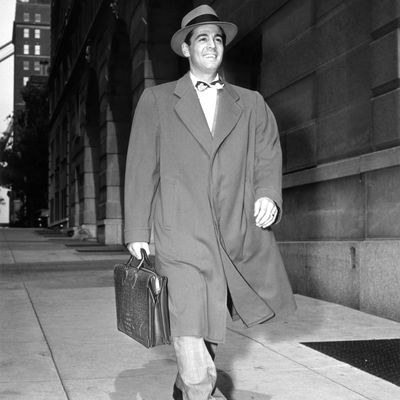
Here at the New York Magazine offices, not far from where I sit, is a very long walkway. It’s not technically a corridor, since it’s bordered on one side by cubicles rather than a wall, but it’s been dubbed the horrordor nonetheless. That’s because when you see someone at the other end of it whom you barely know — and when you’re at work, you’re constantly crossing paths with people you barely know — it’s quite awkward, at least if you’re an awkward person (which I am). For the next 15–20 seconds, you know you’ll be walking toward this person. Do you nod? Smile? Ignore? Some combination of the above? It’s weirdly, deeply unpleasant.
This isn’t a problem unique to our office, of course. I’m sure at some point you have been walking down the street, noticed an acquaintance or friend-of-a-friend-of-a-friend — that is, someone you’re not going to stop and chat with — and then dealt with the ensuing awkwardness of walking toward them but having no idea exactly how to handle the approach. Eye contact is the worst part of these situations. Basic etiquette says we should make eye contact with someone when we notice them, but basic etiquette, not to mention common sense, also says that maintaining eye contact with someone you’re not engaged in a conversation with is creepy. Situations like the horrordor collide these two norms.
Can anything be done about this? Or are those of us with awkward tendencies in for a lifetime of un-fun horrodoresque encounters? I emailed a couple of eye-contact experts to find out.
It’s useful to realize that this isn’t as big a problem everywhere as it is here in New York.
Ronald Riggio, a professor at Claremont McKenna College, pointed out that cultural factors may well exacerbate the horrors of the horrordor. “NY culture is different from my California culture, and in NY the cultural norm is to not make eye contact on the streets, etc.,” he said in an email. Not so in California, where he lives. (Presumably shortly after he hit “send,” he saw a distant acquaintance, made firm eye contact with them, and then smiled warmly at them before offering to split a locally grown avocado for lunch).
Cultural or not, this is a problem — albeit a first-world one — for many of us. And Jeremy Nicholson, a social and personality psychologist who is also known as the Attraction Doctor, said preparation is part of the battle against eye-contact awkwardness. “Before entering a long hallway, or walking on the street, take a moment to center yourself,” he said in an email. “Take a breath and be mindful of the world around you (not just the thoughts buzzing in your head or the gadgets in your pocket).” He also suggested trying to scowl less in general prior to any hallway or street encounters (yet another piece of advice that might be a challenge for New Yorkers). “Develop the habit of softening your eyes and keeping a light smile on your face in public,” he said. “Most of us stare intently at screens most of the day and scowl, which becomes our default expression (i.e. ‘resting bitchface’). But, human interaction is easier with a more neutral-to-positive expression.”
So what do you do when you’re actually walking toward someone? “It seems disingenuous to avoid any eye contact if you know someone,” said Riggio. “There are simple nonverbal cues that can indicate recognition, and that can include brief eye contact with a brief and slight smile and slight nod. Or a very subtle ‘eyebrow flash’ — which is that very brief, slight raising of the eyebrows that is a universal sign of recognition. It would seem acknowledging their presence and some slight nonverbal cue suggesting recognition is appropriate.” Summing all this up, he offered what is a pretty straightforward system: “Make eye contact at 30 ft., break eye contact, brief eye contact and eyebrow flash and 10 feet and then look straight ahead.”
This bookending approach makes a certain sort of sense: You’re acknowledging the person when you first notice them, breaking off eye contact so it doesn’t become sustained and awkward, and then making it again when you’re passing them, because to pass them without another acknowledgement would also feel weird.
Try it! For me, the appeal is less in the specifics — there’s no one right way to handle eye contact in this situation — than in knowing that the next time this happens, I’ll have a plan. I think for people, and, again, particularly those of us toward the awkwarder end of the bell curve, just having a technique in place beforehand matters. When we get frazzled and feel awkward in these situations, it’s because we’re taken by surprise — distracted by something else, we turn a corner, see someone, and go, Oh crap, this person I only sorta know is walking right toward me — what the hell should I do? A clear plan of attack can dispel some of the uncertainty and near-panic.
Nicholson suggested that getting better at these sorts of encounters could bring other benefits as well — not just the avoidance of awkwardness. “Overall, this may not be immediately comfortable or easy — but then, neither is getting on a treadmill again, after a year of laying around. In time, however, hallways and chance street meetings will become much less ‘horrible,’” he said. “In fact, some of those interactions may end up being pleasant coincidences, promotion opportunities, reunions with old friends, or love connections. So, breaking the habits of hiding in our phones, tuning the world out with music, and avoiding random social contact, may be the best thing we can do for both our social lives and professional careers.” Or you could, you know, just call in sick.




